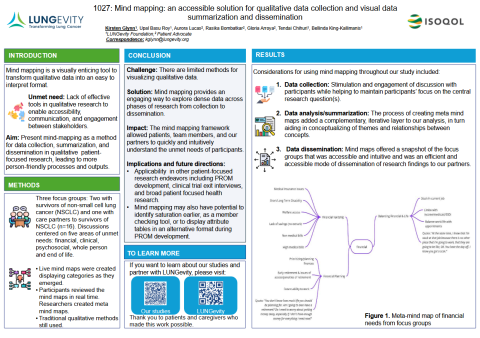Read time: 2 minutes.
Mind mapping, a visual method for organizing complex information, is emerging as a powerful tool in patient-focused research. By structuring data in a format that mirrors how the human brain processes information, mind mapping enables researchers, clinicians, and patients to intuitively navigate nuanced qualitative findings.
“The flexibility and accessibility of mind maps make them ideal for improving communication across research stakeholders,” said Kirsten Glynn, MPH, Research & Engagement Coordinator at LUNGevity. This approach bridges the gap between scientific complexity and person-centered understanding, offering a dynamic way to capture and share the patient voice.
Traditional approaches to qualitative data often struggle to make insights clear or actionable for diverse audiences. “We know that qualitative findings hold tremendous value, but they are not easily represented in graphs or tables,” explained Glynn. This lack of visual accessibility limits how effectively researchers, clinicians, and patients can engage with the data. Mind mapping offers a new path forward, allowing information to be organized in ways that enhance accessibility, engagement, and collaboration.
To explore this approach, the research team conducted two focus groups with survivors of non-small cell lung cancer and one focus group with care partners. During these sessions, mind maps were created in real-time to capture emerging categories and relationships. Participants could review and refine the maps during the discussion, ensuring that the final versions accurately reflected their lived experiences. Researchers then synthesized these into meta-mind maps representing five key areas of unmet need.
Watch this 3-minute video of Kirsten talking about this research project.
The results of this study, presented at the 2025 conference of the International Society for Quality of Life Research, identified three major advantages of mind mapping in qualitative research. First, it encouraged richer, more focused discussions during data collection. Second, creating meta-mind maps added an iterative analytical layer that clarified relationships between themes. Third, it offered an intuitive format for sharing findings.
“Mind maps provided an immediate, visual snapshot that made complex results accessible to everyone—from researchers to patients,” Glynn noted.
The next phase of this work will be a detailed exploration of the broader applications of mind mapping in patient-centered research. The team aims to highlight how this tool can strengthen collaboration and enrich the interpretation of patient experiences across various types of research studies. This approach has the potential to reshape how qualitative data is analyzed and shared.


